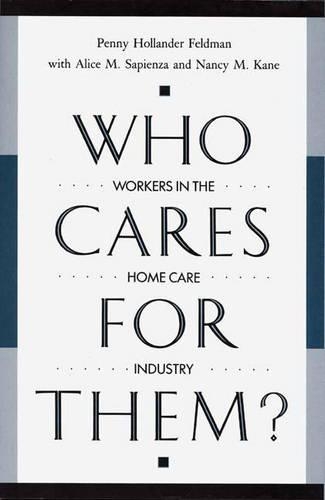
Who Cares for Them: Workers in the Home Care Industry
(Hardback)
Publishing Details
Who Cares for Them: Workers in the Home Care Industry
By (Author) Penny H. Feldman
Bloomsbury Publishing PLC
Praeger Publishers Inc
7th May 1990
United States
Classifications
Tertiary Education
Non Fiction
Emergency services
Care of the elderly
362.63
Physical Properties
Hardback
256
Width 156mm, Height 235mm
567g
Description
Large and growing numbers of the frail elderly and disabled depend on paid workers to assist them in daily life. Who Cares for Them is the first book to document employment conditions in the home care industry and to address issues relating to job satisfaction and turnover among the paraprofessional (home aide) work force. By zeroing in on the workers who are the foundation of the burgeoning home health industry, the authors are able to identify the critical factors that affect the working conditions and job satisfaction of this group. Feldman, Sapienza, and Kane also evaluate the impact of programs that have been designed to improve work life, reduce turnover, and contribute to greater continuity of care, and they present the broader implications for both home care managers and policy makers. Part I explores the home aide labor market. New survey data on the demographic characteristics and attitudes of home aides in five U.S. cities are presented, and financial conditions in the home health care industry that impact on work life issues are analyzed. Parts II and III report on three unique experiments that used changes in pay and benefits, training and support, and hours of work to reduce turnover and increase continuity of care provided by home aides. The case studies of the experiments and the overview of their results provide detailed information that will prove useful for the design and implementation of work life changes in home care agencies. Management strategies and policy options for upgrading home care employment are surveyed in Part IV. This concluding section of the book presents a number of practical recommendations for managers in the home care industry. Policy changes necessary for ensuring a sufficient and reliable supply of workers to meet the growing demand for home care are also outlined. Sixty-two tables, four figures, and a methodological appendix complement this valuable addition to home health care industry literature. Academics in the fields of gerontology, health policy, and health care management, as well as directors and managers of independent home care agencies and policy makers concerned with the supply of personnel and with the financing and delivery of long-term care and home care will find this groundbreaking study filled with important, timely, and useful information.
Reviews
"A benchmark study of home care. Essential reading about the emergence of a major service industry overtaken by escalating needs and an unstable workforce but an industry upon which health care in the future will depend. The analysis is both dramatic and fully documented, skillfully interweaving evidence about a growing helpless sick population, an underpaid and undervalued work force of poor underpaid women and minorities, an underfinanced and fragmented industry, and a beleagured management. The recommendations are practical, growing out of a masterful analysis of the human, the labor force, the managerial and financial and regulatory forces out of which the home care industry is being fashioned."-Robert Morris Cardinal Medeiros Lecturer, Gerontology Institute, University of Massachusetts at Boston
During the last decade we have seen home health care grow more useful and necessary in the health care industry for many important reasons. But as the bureaucracy seemed to grow as quickly as the need for home care, the group of people we depended on for the very survival of the industry seemed to lose both significance and recognition - the home care workers. Low wages, poor benefits, minimal training and agency support and the resulting high turnover have all contributed to a volatile home care work environment. Despite the amount of information and uniqueness of subject matter the authors have carefully categorized and organized every chapter. The purpose of the study, its set-up, implementation and evaluation were thoroughly presented in easily read text including numerous, helpful tables...-Clinical Gerontologist
"During the last decade we have seen home health care grow more useful and necessary in the health care industry for many important reasons. But as the bureaucracy seemed to grow as quickly as the need for home care, the group of people we depended on for the very survival of the industry seemed to lose both significance and recognition - the home care workers. Low wages, poor benefits, minimal training and agency support and the resulting high turnover have all contributed to a volatile home care work environment. Despite the amount of information and uniqueness of subject matter the authors have carefully categorized and organized every chapter. The purpose of the study, its set-up, implementation and evaluation were thoroughly presented in easily read text including numerous, helpful tables..."-Clinical Gerontologist
Author Bio
PENNY HOLLANDER FELDMAN is Lecturer in Political Science in the Department of Health Policy and Management, Harvard School of Public Health. Among her recent publications are Recruiting an Elite: Admission to Harvard College (1987) and, with Alice M. Sapienza, the chapter Strategic Management of Quality of Worklife in the Home Care Industry in Human Resource Management in the Health Care Sector: A Guide for Administrators and Professionals (Greenwood Press, 1989). ALICE M. SAPIENZA is Assistant Professor of Management in the Department of Health Policy and Management, Harvard School of Public Health. In addition to her work in home care, she has published several recent articles on the management and diffusion of biotechnology in the United States and abroad. NANCY M. KANE is Assistant Professor of Management in the Department of Health Policy and Management, Harvard School of Public Health. Her recent publications include Home Care Crisis of the Nineties, which appeared in The Gerontologist (1989).
